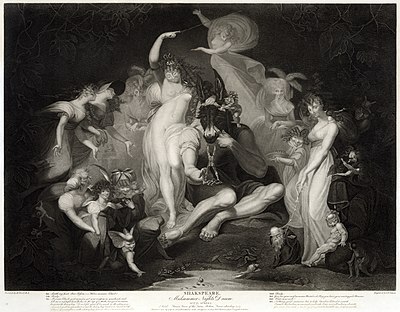| Revision as of 09:40, 1 November 2011 editAlarbus (talk | contribs)7,569 edits Clean up, blockquote, poem← Previous edit | Revision as of 09:41, 1 November 2011 edit undoAlarbus (talk | contribs)7,569 edits Clean upNext edit → | ||
| Line 11: | Line 11: | ||
| <blockquote> | <blockquote> | ||
| <poem> | <poem> | ||
| ''I know a bank where the wild thyme blows,'' | |||
| ''Where oxlips and the nodding violet grows,'' | |||
| ''Quite over-canopied with luscious woodbine,'' | |||
| ''With sweet musk-roses and with eglantine:'' | |||
| ''There sleeps Titania sometime of the night,'' | |||
| ''Lull'd in these flowers with dances and delight;'' | |||
| ''And there the snake throws her enamell'd skin,'' | |||
| ''Weed wide enough to wrap a fairy in'' | |||
| </poem> | </poem> | ||
| </blockquote> | </blockquote> | ||
Revision as of 09:41, 1 November 2011
For other uses, see Titania (A Midsummer Night's Dream) (disambiguation).
Titania is the name of a character in William Shakespeare's play A Midsummer Night's Dream. In Shakespeare's play, she is the queen of the fairies. Due to Shakespeare's influence, later fiction has often used the name "Titania" for fairy queen characters.
In traditional folklore, the fairy queen has no name. Shakespeare took the name 'Titania' from Ovid's Metamorphoses, where it is an appellation given to the daughters of Titans.
In the Shakespeare play, Titania is a very proud creature and as much of a force to contend with as her husband Oberon. The marital quarrel she and Oberon are engaged in over which of them should have the keeping of an Indian changeling boy is the engine that drives the mix ups and confusion of the other characters in the play. Due to an enchantment cast by Oberon's servant Puck, Titania magically falls in love with a rude mechanical (a lower class labourer), Nick Bottom the Weaver, who has been given the head of an ass by Puck, who feels it is better suited to his character (which bears a resemblance to the story of Lycaon).
Oberon states in the play:
I know a bank where the wild thyme blows,
Where oxlips and the nodding violet grows,
Quite over-canopied with luscious woodbine,
With sweet musk-roses and with eglantine:
There sleeps Titania sometime of the night,
Lull'd in these flowers with dances and delight;
And there the snake throws her enamell'd skin,
Weed wide enough to wrap a fairy in
Fairy's view on human mortality
In the second act, Titania refers to the Athenians as "human mortals." Scholar John Hale interprets this as a reference to the mortality of humans from the faerie point of view, indicative of Shakespeare's ability to write from the perspective of all of his characters. Titania's use of the word "mortal" both looks down upon and sympathizes with youths.
Other historical references
Subsequently, Titania has appeared in many other paintings, poems, plays and even graphic novels. For instance, she is a pivotal character in The Books of Magic series and its spinoff The Books of Faerie.
Johann Wolfgang von Goethe took the figures from Shakespeare's work to Faust I. Titania is married to Oberon, and the couple is celebrating its golden wedding anniversary in Faust I.
Titania is also the largest of Uranus's moons, among others that are also named after Shakespearian characters and those of Alexander Pope.
Alfred Lord Tennyson's play The Foresters, which is a Robin Hood story, has a brief segment with Titania, queen of the Fairies.
In Neil Gaiman's Sandman Titania appears repeatedly. In one story, Morpheus commissions William Shakespeare to perform A Midsummer Night's Dream before Titania and her court. Although the faeries are incredulous at first, they become enraptured by the end of the performance.
Titania appeared in Gargoyles, Here she was a member of a race of humanoid beings possessed of godlike or semi-divine power, which humans called "Oberon's Children" or the Third Race, and she appeared to be a tall, buxom green-skinned She was previously exiled from the Third Race's interdimensional homeland due to some incident in the past, and was married to the anti-heroic king of the Third Race, Oberon.
Titania appears in The Dresden Files as the Current Queen of the Seelie Courts (Summer).
References
- Holland, Peter, ed. A Midsummer Night's Dream (OUP, 1994)
- Hale, John, Shakespeare's A Midsummer Night's Dream 2.1.101